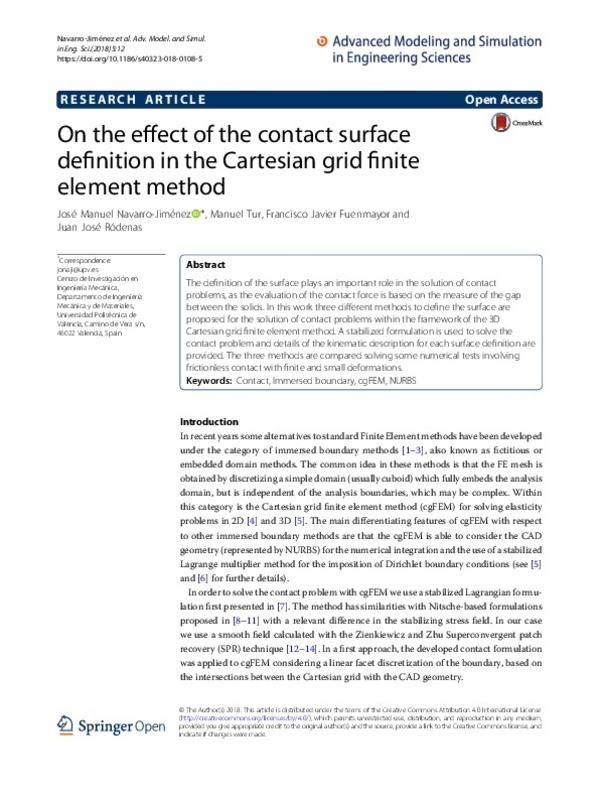Düster a, Parvizian J, Yang Z, Rank E. The finite cell method for three-dimensional problems of solid mechanics. Comput Methods Appl Mech Eng. 2008;197(45–48):3768–82. https://doi.org/10.1016/j.cma.2008.02.036 .
Schillinger D, Ruess M. The finite cell method: a review in the context of higher-order structural analysis of CAD and image-based geometric models. Arch Comput Methods Eng. 2015;22(3):391–455. https://doi.org/10.1007/s11831-014-9115-y .
Burman E, Claus S, Hansbo P, Larson MG, Massing A. CutFEM: discretizing geometry and partial differential equations. Int J Numer Methods Eng. 2015;104(7):472–501. https://doi.org/10.1002/nme.4823 .
[+]
Düster a, Parvizian J, Yang Z, Rank E. The finite cell method for three-dimensional problems of solid mechanics. Comput Methods Appl Mech Eng. 2008;197(45–48):3768–82. https://doi.org/10.1016/j.cma.2008.02.036 .
Schillinger D, Ruess M. The finite cell method: a review in the context of higher-order structural analysis of CAD and image-based geometric models. Arch Comput Methods Eng. 2015;22(3):391–455. https://doi.org/10.1007/s11831-014-9115-y .
Burman E, Claus S, Hansbo P, Larson MG, Massing A. CutFEM: discretizing geometry and partial differential equations. Int J Numer Methods Eng. 2015;104(7):472–501. https://doi.org/10.1002/nme.4823 .
Nadal E, Ródenas JJ, Albelda J, Tur M, Tarancón JE, Fuenmayor FJ. Efficient finite element methodology based on cartesian grids: application to structural shape optimization. Abstr Appl Anal. 2013;2013:1–19. https://doi.org/10.1155/2013/953786 .
Marco O, Sevilla R, Zhang Y, Ródenas JJ, Tur M. Exact 3D boundary representation in finite element analysis based on Cartesian grids independent of the geometry. Int J Numer Methods Eng. 2015;103(6):445–68. https://doi.org/10.1002/nme.4914 .
Tur M, Albelda J, Marco O, Ródenas JJ. Stabilized method of imposing Dirichlet boundary conditions using a recovered stress field. Comput Methods Appl Mech Eng. 2015;296:352–75. https://doi.org/10.1016/j.cma.2015.08.001 .
Tur M, Albelda J, Navarro-Jimenez JM, Rodenas JJ. A modified perturbed Lagrangian formulation for contact problems. Comput Mech. 2015;55(4):737–54. https://doi.org/10.1007/s00466-015-1133-6 .
Heintz P, Hansbo P. Stabilized Lagrange multiplier methods for bilateral elastic contact with friction. Comput Methods Appl Mech Eng. 2006;195(33–36):4323–33. https://doi.org/10.1016/j.cma.2005.09.008 .
Annavarapu C, Hautefeuille M, Dolbow JE. A Nitsche stabilized finite element method for frictional sliding on embedded interfaces. Part I: single interface. Comput Methods Appl Mech Eng. 2014;268:417–36. https://doi.org/10.1016/j.cma.2013.09.002 .
Poulios K, Renard Y. An unconstrained integral approximation of large sliding frictional contact between deformable solids. Comput Struct. 2015;153:75–90. https://doi.org/10.1016/j.compstruc.2015.02.027 .
Mlika R, Renard Y, Chouly F. An unbiased Nitsche’s formulation of large deformation frictional contact and self-contact. Comput Methods Appl Mech Eng. 2017;325:265–88. https://doi.org/10.1016/J.CMA.2017.07.015 .
Zienkiewicz OC, Zhu JZ. The superconvergent patch recovery and a posteriori error estimates. Part 1: the recovery technique. Int J Numer Methods Eng. 1992;33:1331–64. https://doi.org/10.1002/nme.1620330702 .
Ródenas JJ, Tur M, Fuenmayor FJ, Vercher A. Improvement of the superconvergent patch recovery technique by the use of constraint equations: The SPR-C technique. Int J Numer Methods Eng. 2007;70:705–27. https://doi.org/10.1002/nme.1903 .
González-Estrada OA, Ródenas JJ, Bordas SPA, Nadal E, Kerfriden P, Fuenmayor FJ. Locally equilibrated stress recovery for goal oriented error estimation in the extended finite element method. Comput Struct. 2015;152:1–10. https://doi.org/10.1016/j.compstruc.2015.01.015 .
Wriggers P, Krstulovic-Opara L, Korelc J. Smooth c1-interpolations for two-dimensional frictional contact problems. Int J Numer Methods Eng. 2001;51(12):1469–95. https://doi.org/10.1002/nme.227 .
Padmanabhan V, Laursen TA. A framework for development of surface smoothing procedures in large deformation frictional contact analysis. Finite Elem Anal Design. 2001;37(3):173–98. https://doi.org/10.1016/S0168-874X(00)00029-9 .
Tur M, Giner E, Fuenmayor FJ, Wriggers P. 2d contact smooth formulation based on the mortar method. Comput Methods Appl Mech Eng. 2012;247–248:1–14. https://doi.org/10.1016/j.cma.2012.08.002 .
Stadler M, Holzapfel GA, Korelc J. Cn continuous modelling of smooth contact surfaces using NURBS and application to 2D problems. Int J Numer Methods Eng. 2003;57(15):2177–203. https://doi.org/10.1002/nme.776 .
Puso MA, Laursen TA. A 3d contact smoothing method using gregory patches. Int J Numer Methods Eng. 2002;54(8):1161–94. https://doi.org/10.1002/nme.466 .
Neto DM, Oliveira MC, Menezes LF, Alves JL. A contact smoothing method for arbitrary surface meshes using nagata patches. Comput Methods Appl Mech Eng. 2016;299:283–315. https://doi.org/10.1016/j.cma.2015.11.011 .
Hughes TJR, Cottrell Ja, Bazilevs Y. Isogeometric analysis: CAD, finite elements, NURBS, exact geometry and mesh refinement. Comput Methods Appl Mech Eng. 2005;194(39–41):4135–95. https://doi.org/10.1016/j.cma.2004.10.008 .
De Lorenzis L, Wriggers P, Hughes TJR. Isogeometric contact: a review. GAMM-Mitteilungen. 2014;37(1):85–123. https://doi.org/10.1002/gamm.201410005 .
Dittmann M, Franke M, Temizer I, Hesch C. Isogeometric analysis and thermomechanical mortar contact problems. Comput Methods Appl Mech Eng. 2014;274:192–212. https://doi.org/10.1016/j.cma.2014.02.012 .
Corbett CJ, Sauer RA. NURBS-enriched contact finite elements. Comput Methods Appl Mech Eng. 2014;275:55–75. https://doi.org/10.1016/J.CMA.2014.02.019 .
Corbett CJ, Sauer RA. Three-dimensional isogeometrically enriched finite elements for frictional contact and mixed-mode debonding. Comput Methods Appl Mech Eng. 2015;284:781–806. https://doi.org/10.1016/j.cma.2014.10.025 .
Navarro-Jiménez JM, Tur M, Albelda J, Ródenas JJ. Large deformation frictional contact analysis with immersed boundary method. Computational Mechanics. 2018; 1–18. https://doi.org/10.1007/s00466-017-1533-x .
Lorensen WE, Cline HE, Lorensen WE, Cline HE. Marching cubes: a high resolution 3D surface construction algorithm. In: Proceedings of the 14th annual conference on computer graphics and interactive techniques—SIGGRAPH ’87, vol. 21. 1987. p. 163–169. New York: ACM Press. https://doi.org/10.1145/37401.37422 . http://portal.acm.org/citation.cfm?doid=37401.37422 .
Sevilla R, Fernández-Méndez S, Huerta A. NURBS-enhanced finite element method (NEFEM). Int J Numer Methods Eng. 2008;76:56–83. https://doi.org/10.1002/nme.2311 .
Hüeber S, Mair M, Wohlmuth BI. A priori error estimates and an inexact primal-dual active set strategy for linear and quadratic finite elements applied to multibody contact problems. Appl Numer Math. 2005;54(3–4):555–76. https://doi.org/10.1016/J.APNUM.2004.09.019 .
Tur M, Fuenmayor FJ, Wriggers P. A mortar-based frictional contact formulation for large deformations using Lagrange multipliers. Comput Methods Appl Mech Eng. 2009;198(37–40):2860–73. https://doi.org/10.1016/j.cma.2009.04.007 .
[-]









